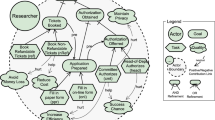Abstract
The requirements analysis of critical software components often involves a search for hazardous states and failure modes. This paper describes the integration of a forward search for consequences of reaching these forbidden modes with a backward search for contributing causes. Results are reported from two projects in which the integrated search method was used to analyze the requirements of critical spacecraft software. The search process was found to be successful in identifying some ambiguous, inconsistent, and missing requirements. More importantly, it identified four significant, unresolved requirements issues involving complex system interfaces and unanticipated dependencies. The results suggest that recent efforts by researchers to integrate forward and backward search have merit.
Similar content being viewed by others
References
Addy, E.A. (1991), “A Case Study on Isolation of Safety-Critical Software,” In Proceedings of the 6th Annual Conference on Computer Assurance, NIST/IEEE, Gaithersburg, MD, pp. 75–83.
Alur, R., T.A. Henzinger, and Pei-Hsin Ho (1996), “Automatic Symbolic Verification of Embedded Systems,” In IEEE Transactions on Software Engineering 22,3, 181–201.
Atlee, J.M. and J. Gannon (1993), “State-Based Model Checking of Event-Driven System Requirements,” IEEE Transactions on Software Engineering 19,1, 24–40.
Bestavros, A.A., J.J. Clark, and N.J. Ferrier (1990), “Management of Sensori-Motor Activity in Mobile Robots,” In Proceedings of the 1990 IEEE International Conference on Robotics and Automation, IEEE Computer Society Press, Cincinnati, OH, pp. 592–597.
Cha, S.S., N.G. Leveson, and T.J. Shimeall (1991), “Safety Verification of Ada Programs Using Fault Tree Analysis,” In IEEE Software 8,4, 48–59.
Chillarege, R., I. Bhandari, J. Chaar, M. Halliday, D. Moebus, B. Ray, and M.-Y. Wong (1992), “Orthogonal Defect Classification — A Concept for In-Process Measurements,” IEEE Transactions on Software Engineering 18,11, 943–956.
Crow, J. and B.L. Di Vito (1996), “Formalizing Space Shuttle Software Requirements,” In Proceedings of the ACM SIGSOFT Workshop on Formal Methods in Software Practice, San Diego, CA.
De Lemos, R., A. Saeed, and T. Anderson (1995), “Analyzing Safety Requirements for Process-Control Systems,” IEEE Software 12,3, 42–53.
FEAT (Failure Environment Analysis Tool), NASA Software Technology Transfer Center, Cosmic #MSC-21873 and #MSC-22446.
Fencott, C. and B. Hebbron (1995), “The Application of HAZOP Studies to Integrated Requirements Models for Control Systems,” ISA Transactions 34, 297–308.
FIRM (Failure Identification and Risk Management Tool), NASA Software Technology Transfer Center, Cosmic #MSC-21860.
Fragola, J.R. and J.F. Spahn (1973), “The Software Error Effects Analysis; A Qualitative Design Tool,” In Proceedings of the 1973 IEEE Symposium on Computer Software Reliability, IEEE, New York, pp. 90–93.
Heimdahl, M.P.E. and N.G. Leveson (1996), “Completeness and Consistency in Hierarchical State-Based Requirements,” IEEE Transactions on Software Engineering 22,6, 363–377.
Heitmeyer, C., A. Bull, C. Gasarch, and B. Labaw (1995), “SCR: A Toolset for Specifying and Analyzing Requirements,” In Proceedings of the 10th Annual Conference on Computer Assurance, IEEE, Gaithersburg, MD, pp. 109–122.
Hu, A.J., D.L. Dill, A.J. Drexler, and C. Han Yang (1993), “Higher-Level Specification and Verification with BDDs,” In Proceedings of Computer Aided Verification: Fourth International Workshop, G.V. Bochmann and D.K. Probst, Eds., Lecture Notes in Computer Science, Vol. 663, Springer-Verlag, Berlin.
IEEE Standard Glossary of Software Engineering Terminology (1990), IEEE Std 610.12-1990, IEEE, New York.
Lamport, L. and N. Lynch (1990), “Distributed Computing Models and Methods,” In Handbook of Theoretical Computer Science, Vol. B, Formal Models and Semantics, J. van Leeuwen, Ed., MIT Press/Elsevier, Cambridge/Amsterdam, 1990, pp. 1157–1199.
Leveson, N. (1995), Safeware, System Safety and Computers, Addison-Wesley, Reading, MA.
Lutz, R. (1996), “Analyzing Software Requirements Errors in Safety-Critical, Embedded Systems,” The Journal of Systems and Software 34, 223–230.
Lutz, R. and Y. Ampo (1994), “Experience Report: Using Formal Methods for Requirements Analysis of Critical Spacecraft Software,” In Proceedings for the 19th Annual Software Engineering Workshop, NASA Goddard Space Flight Center, Greenbelt, MD, pp. 231–236.
Maier, T. (1995), “FMEA and FTA To Support Safe Design of Embedded Software in Safety-Critical Systems,” In CSR 12th Annual Workshop on Safety and Reliability of Software Based Systems, Bruges, Belgium.
McDermid, J.A., M. Nicholson, D.J. Pumfrey, and P. Fenelon (1995), “Experience with the Application of HAZOP to Computer-Based Systems,” In Proceedings of the 10th Annual Conference on Computer Assurance, IEEE, Gaithersburg, MD, pp. 37–48.
McDermid, J.A. and D.J. Pumfrey (1994), “A Development of Hazard Analysis To Aid Software Design,” In Proceedings of the 9th Annual Conference on Computer Assurance, IEEE, Gaithersburg, MD, pp. 17–25.
Military Standard (1980), Procedures for Performing a Failure Mode, Effects and Criticality Analysis MIL-STD-1629A.
Nakajo, T. and H. Kume (1991), “A Case History Analysis of Software Error Cause-Effect Relationship,” IEEE Transactions on Software Engineering 17,8, 830–838.
Ostrand, T.J. and E.J. Weyuker (1984), “Collecting and Categorizing Software Error Data in an Industrial Environment,” The Journal of Systems and Software 4, 289–300.
Project Reliability Group (1990), Reliability Analyses Handbook, D-5703, Jet Propulsion Laboratory, California Institute of Technology, Pasadena, CA.
Reifer, D.J. (1979), “Software Failure Modes and Effects Analysis,” IEEE Transactions on Reliability R-28,3, 247–249.
Selby, R.W. and V.R. Basili (1991), “Analyzing Error-Prone System Structure,” IEEE Transactions on Software Engineering 17,2, 141–152.
Sommerville, I. (1996), Software Engineering, Fifth Edition, Addison-Wesley, Reading, MA.
System Safety Society (1993), System Safety Analysis Handbook, System Safety Society, Sterling, VA.
Tanenbaum, A.S. (1992), Modern Operating Systems, Prentice-Hall, Englewood Cliffs, NJ.
Wunram, J. (1990), “A Strategy for Identification and Development of Safety Critical Software Embedded in Complex Space Systems,” IAA 90-557, 35–51.
Author information
Authors and Affiliations
Rights and permissions
About this article
Cite this article
Lutz, R.R., Woodhouse, R.M. Requirements analysis using forward and backward search. Annals of Software Engineering 3, 459–475 (1997). https://doi.org/10.1023/A:1018929719710
Issue Date:
DOI: https://doi.org/10.1023/A:1018929719710




